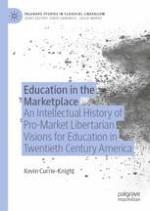2019 | OriginalPaper | Chapter
6. Milton (and Rose) Friedman: Education Vouchers and State Financing of Private Education
Author : Kevin Currie-Knight
Published in: Education in the Marketplace
Publisher: Springer International Publishing
Activate our intelligent search to find suitable subject content or patents.
Select sections of text to find matching patents with Artificial Intelligence. powered by
Select sections of text to find additional relevant content using AI-assisted search. powered by
